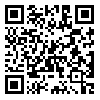Volume 18, Issue 4 (2016)
JAST 2016, 18(4): 1143-1152 |
Back to browse issues page
1- Plant Pathology Department, Faculty of Agriculture, Mansoura University, Mansoura 35516, Egypt.
2- Agricultural Chemistry Department, Faculty of Agriculture, Mansoura University, Mansoura 35516, Egypt.
3- Agricultural Chemistry Department, Faculty of Agriculture, Damietta University, Damietta, Egypt.
2- Agricultural Chemistry Department, Faculty of Agriculture, Mansoura University, Mansoura 35516, Egypt.
3- Agricultural Chemistry Department, Faculty of Agriculture, Damietta University, Damietta, Egypt.
Abstract: (10178 Views)
The fungus Cochliobolus is the teleomorph of Bipolaris and Curvularia which are economically important plant pathogens worldwide. Several species of Bipolaris are well documented human pathogens. The aim of the present study was to evaluate the efficacy of the essential oil of Ocimum basilicum against some Bipolaris and Cochliobolus species. Sixteen compounds, representing 95.4% of the chemical components of the essential oil of Ocimum basilicum, were identified by Gas Chromatography–Mass Spectrometry (GC-MS). The main compounds were estragole (55.95%), 1,8-Cineole (10.56%), methyl eugenol (10.09%) and linalool (5.57%). Aromatic oxygenated monoterpenes (57.42%) were the dominant constituents of the essential oil followed by oxygenated monoterpenes (16.13%) and sesquiterpene hydrocarbons (6.9%). The essential oil exhibited a complete inhibition of the growth of Bipolaris ellisii, Bipolaris hawaiensis, Bipolaris spicifera, Cochliobolus australiensis andCochliobolus cynodontis at 80 mg/mL and fungicidal effect on Cochliobolus australiensis only at the same concentration after six and twelve days of exposure. Spore germination and germ tube elongation of B. hawaiensis were completely inhibited by the essential oil (at 40 mg/mL) and B. spicifera (at 80 mg/mL) with minimum inhibitory concentration (MIC) values ranging from 40 to 160 mg/mL. These results suggest that the essential oil of Ocimum basilicum is a potential and promising antifungal tool for controlling plant and human fungal pathogens.
Article Type: Research Paper |
Subject:
Plant Pathology
Received: 2015/01/31 | Accepted: 2015/09/2 | Published: 2016/07/1
Received: 2015/01/31 | Accepted: 2015/09/2 | Published: 2016/07/1
| Rights and permissions | |
 |
This work is licensed under a Creative Commons Attribution-NonCommercial 4.0 International License. |


